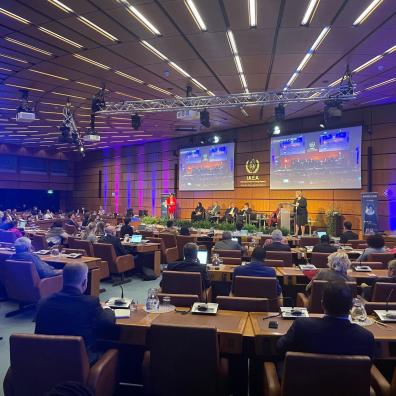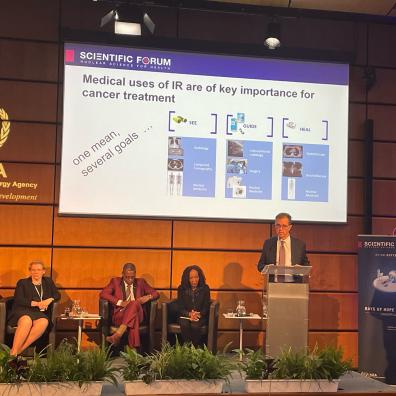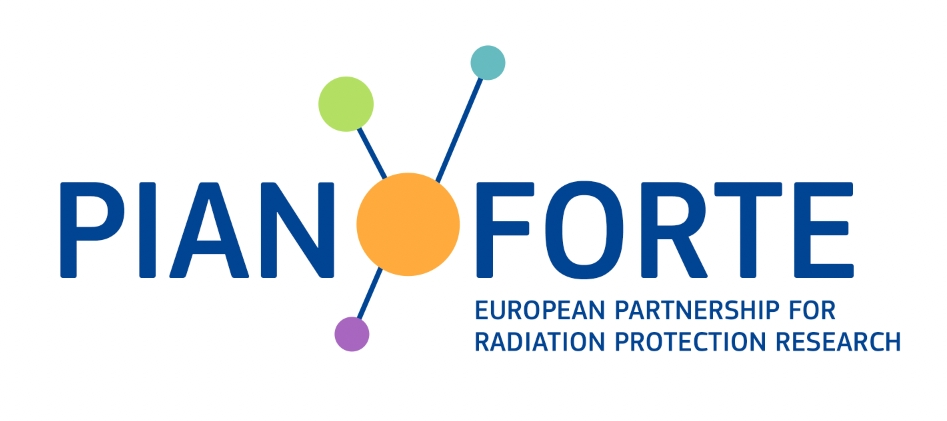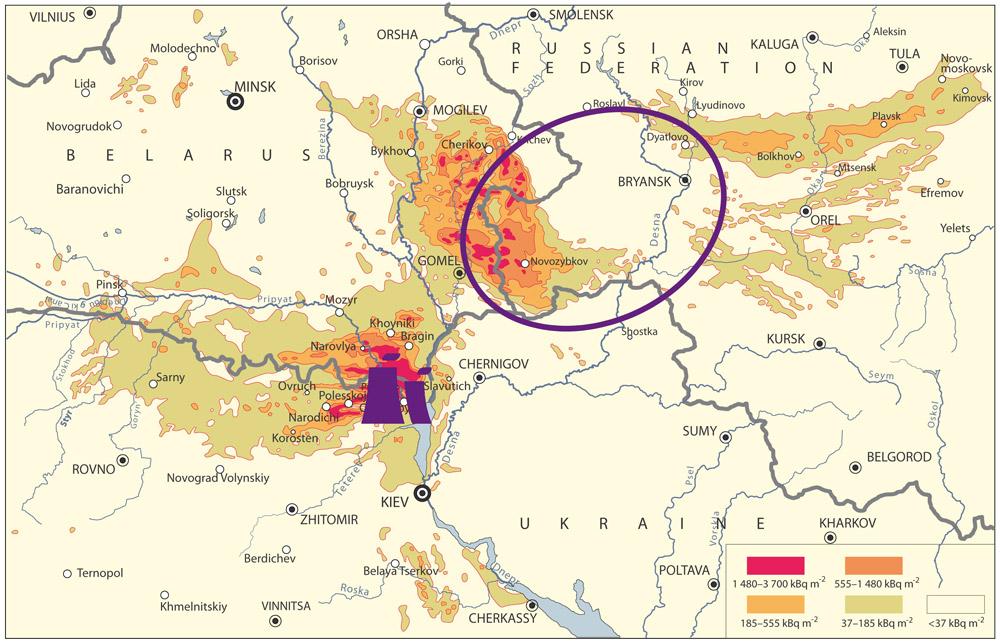Ionising radiation and fight against cancer: the contribution of research
On the eve of the World Cancer Day, IRSN organised in partnership with CEA, Inserm and CNRS [1], a conference dedicated to the contribution of research on the use of ionising radiation to the fight against cancer.
This venue organised under the auspices of Marie-France Bellin and Jean-Christophe Niel, respectively chair of the board and director general at IRSN, took place at Maison Irène et Frédéric Joliot Curie, the Brussels base of several major French research institutions. Structured around three headlines – French strategy and roadmap, state-of-the-art research, and European and international actions – the presentations and debates among scientists, academics and representatives from government and international organisations highlighted the challenges, progress made, and future prospects of scientific research in medical applications such as imaging, nuclear medicine or radiotherapy where radiation technologies are used for diagnosis and/or therapy.
Acknowledging improvements achieved in cancer diagnosis and treatment
In France, like in many European countries, the use of ionising radiation in cancer diagnosis and treatment keeps growing with over 55% of patients being treated by radiotherapy. This constant increase raises many questions – e.g. on the benefit/risk balance of innovative radiation technologies (new radiopharmaceuticals, Proton-therapy or Flash-therapy), the development of combined treatment to cure radioresistant tumours or the adverse effects and the patient quality of life. These questions require in turn further research aimed at developing ever more efficient and less affecting therapeutic strategies. In this regard, the participants in the conference acknowledged the progress made over the past years in terms of improved benefit/risk balance, increased life expectancy and higher quality of life through reduced side effects, just to name a few.
Shaping the future of treatments
The presentations and debates were an opportunity to address major benefits expected from research projects from different perspectives:
- Enhanced therapy efficiency through innovative irradiation modalities such as hadrontherapy, spatial fractionation, flash therapy, drug-assisted targeting (using e.g. nanoparticles);
- The further improvement of the benefit/risk balance of imaging and treatments with, in particular, the contribution of artificial intelligence (AI) and machine learning to obtaining high-quality imaging with lower dose intake;
- The prevention of adverse effects from treatments, the reduction of the toxic effects of radiotherapy on healthy tissues, or the occurrence of immunosuppressive and/or long-term effects, thanks to AI-guided dose delivery;
- The benefit from new approaches in nuclear medicine such as theranostics (the combined use of one radionuclide to diagnose and a second one to treat the tumour, main and any metastatic), or the combined use of radiotherapy with other therapies (immunotherapy, hormonotherapy …);
- The trend towards personalised medicine based on patient-centric, cross-disciplinary approaches taking into account individual patient parameters and personalised dosimetry;
- The development of ultra-precision radio-immunotherapy using imaging-biomarkers for efficient treatment of oligometastatic patients…
Addressing challenges
Most of the prospects mentioned above require disruptive approaches based notably on the development of multidisciplinary and multi-scale approaches which entail the integration of teams working in various fields to deal with the diversity in tumour and non-tumour tissue response e.g. physicochemical, molecular, and physiological phenomena. Other challenges associated with the rapid evolution in cancer diagnosis and treatment techniques pertain for instance to the quality assurance in radiotherapy, the secured production of radioisotopes, the funding of state-of-the-art research drawing upon ever more sophisticated equipment or the equal access to radiological medicine, as well as the safety of caregivers and patients, calling for the involvement of patient associations in future developments.
Tackling such challenges is key to the success of research activities carried out as part of strategic plans at national, European and international levels, such as the French 10-year strategy against cancer, the Europe's Beating Cancer Plan or the IAEA's Rays of Hope initiative. It is for instance the sense of major research projects conducted as part of European framework programmes for research and innovation (H2020/EURATOM and Horizon Europe), such as Rocc-N-Roll, an integrated and coordinated European approach for innovation and research in the field of medical applications using ionising radiation, and PIANOFORTE, an IRSN-coordinated partnership aimed to contribute improving the protection of the public, workers, patients against environmental, occupational and medical exposure to ionising radiation. This partnership also intends to foster the management of research programmes at scientific community level through open research calls.
Note:
- Alternative Energies and Atomic Energy Commission (CEA), National Institute of Health and Medical Research (Inserm) and National Centre for Scientific Research (CNRS).
IAEA General Conference: IRSN highlights participatory medicine
Each year, the International Atomic Energy Agency (IAEA) organizes its General Conference bringing together representatives of Member States. This general conference is an opportunity for Member States to share information on their national nuclear programs and various current issues, particularly in the scientific field. This 66th edition takes place from September 26 to 30, 2022 in Vienna (Austria). Jean-Christophe Niel, Director General of IRSN, will meet some of his counterparts in other delegations and will discusse future collaborations in terms of safety and radiation protection.

On the sidelines of the General Conference, the IAEA organizes its scientific forum : the theme of this year is the fight against cancer. Through his participation in this forum, Jean-Christophe Niel emphasized participatory medicine with the involvement of patients in their treatment. He also highlighted the issues around the perception of risk and communication to compare benefits and disadvantages, as well as the equality of patients in the face of the risks associated with cancer treatments. Finally, within the framework of the IAEA's Rays of Hope initiative, Jean-Christophe Niel presents the joint will of the IRSN and the IAEA to unite their efforts in the field of the fight against cancer through the establishment of a Collaborating Center.

During the week, IRSN also organizes a side event, centered on research platforms. The latter reviews the contribution of technical and experimental platforms and research data to strengthening nuclear safety. He stresses the need to secure their future as nuclear programs are relaunched in many countries. Each organization involved in a collaborative research project developed on these platforms has access to all research results faster and also to shared costs. These platforms are also an essential training tool for the younger generation and allow the development of a community of qualified experts.
IRSN designated as a WHO “Collaborating Center” once again
Following a visit from a World Health Organization (WHO) delegation end of 2021, IRSN has been reappointed as a collaborating center for its fourth four-year term.
Under its activities, WHO calls on some 800 collaborating centers in 80 member states to support its work in a multitude of health-related fields that includes epidemics and pandemics, nutrition, infectious and non-communicable diseases, and preparedness, surveillance and response in health emergencies.
IRSN has been appointed four times to a four-year term as a collaborating center in this final field – first in 2010, then again in 2014, 2018 and 2022.
The Institute helps WHO to develop standards, draw up research agendas, provide technical support during radiological or nuclear emergencies, and share knowledge related to the medical/health consequences of radiological and nuclear risks. Four priority areas have been determined:
- strengthening preparedness and response to radiation emergencies;
- providing technical support in the area of mental health and psychosocial support in radiation emergencies;
- providing technical support in the area of radiation protection in medical applications of ionizing radiation;
- providing technical support in the area of existing radiation exposures.
The renewal of its status as a collaborating center reflects recognition of the Institute’s scientific and technical work.
Through WHO, IRSN also has the opportunity to share its proposals and recommendations in the field of health research with its counterparts – as well as their own recommendations – on a much wider international scale.
Launch of the "PIANOFORTE" European partnership: research and education for radiation protection

Launched on June 14, 2022 in Paris, the PIANOFORTE research partnership has the ambition to improve knowledge and promote innovation in the field of radiation protection for the benefit of better protection of the public, patients, workers and the environment in all scenarios of exposure to ionizing radiation.
The European Partnership for Radiation Protection Research will contribute to improving the protection of the public, workers, patients and the environment from environmental, occupational and medical exposure to ionizing radiation. It brings together 58 partners representing 22 European Union countries as well as the United Kingdom and Norway, and is coordinated by the French Institute for Radiation Protection and Nuclear Safety (IRSN). It is co-financed by the European Union's EURATOM program and the Member States of the participating countries. Through the research activities that will be carried out within its framework, PIANOFORTE will contribute to the implementation of European policies such as the European plan to combat cancer, the green pact for growth, and the implementation of the roadmap for reducing industrial and natural risks.
Through the scientific challenges it will address, this partnership aims to contribute to priority European policies such as the fight against cancer (European Cancer Action Plan), the protection of health from environmental risks (Green Pact for Growth) and finally the improvement of anticipation and resilience in disaster situations (implementation of the Sendai Framework for Disaster Risk Reduction).
Within this partnership, at least three calls for proposals, open to the entire European research community for radiation protection, will be organized between 2023 and 2025. They will focus on the following four themes:
- improving patient radiation protection in relation to the use of ionizing radiation in the medical field
- a better comprehension of variability of individual response to exposure to ionizing radiation
- the study of mechanisms involved in chronic exposure to low doses of ionizing radiation
- the improvement of anticipation capacities and resilience in nuclear or radiological crisis situations and post-accident management.
Particular attention will be paid to the involvement of all stakeholders (authorities, civil society, radiation protection practitioners, experts, etc.) in the priority setting of the scientific topics that will be the subject of calls for tender and with respect to the question of translating this research into actual impact for strengthened radiation protection. The objective is to meet and integrate the expectations of the wide set of radiation protection stakeholders as best as possible. This partnership also specifically aims to build bridges with research activities carried out at European level in the "non-Euratom" fields, in particular in the health sector.
Beyond these research activities, PIANOFORTE will contribute to maintaining a sustainable capacity of expertise in radiation protection in Europe, which is internationally recognized, in particular by promoting the availability, use and sharing of existing state-of-the-art research infrastructures at the European level as well as by implementing education and training activities.
The partnership will build on previous work, and in particular on the results of the European joint program CONCERT conducted under the H2020 framework program which ended in 2020. It will also benefit from the achievements of other European projects just completed or in progress such as MEDIRAD, HARMONIC, RadoNorm or SINFONIA.
To date, PIANOFORTE involves 58 partners from 22 EU countries as well as the UK and Norway. It mobilizes public partners (public research organizations, authorities in the field of radiation protection, universities) but also the six European research platforms in radiation protection (MELODI, EURADOS, EURAMED, NERIS, ALLIANCE and SHARE). This initial consortium is expected to expand with the entities that will be selected in the framework of the open calls for tenders organized during the partnership.
The partnership will last 5 years and is expected to end in 2027. The estimated budget for PIANOFORTE is 46 million euros, 65% of which will be financed by the European Union and the rest by the partner countries. IRSN is the coordinator of the partnership.
Study on the implementation of linear accelerators coupled with a nuclear magnetic resonance imaging system in radiotherapy (MR-linacs)
In the frame of the marketing of new radiation therapy devices coupling a linear electron accelerator to a magnetic resonance imaging system (MR-linac), the French Nuclear Safety Authority requested IRSN to provide a state of the art for this technology and to identify any points requiring vigilance.
IRSN's analysis relied on the expertise of the French Medical Physics Society, SFPM. The numerous observations and recommendations established by the IRSN/SFPM working group are synthesized in the advice published by the IRSN.
Download IRSN Report 2018-00232 : Request for a study on the implementation of linear accelerators coupled with a nuclear magnetic resonance imaging system in radiotherapy (MR-linacs) (PDF)
Health consequences of low-dose radiation exposure in the context of a nuclear accident
The epidemiological study EPICE provides well-documented answers regarding non-cancerous radiation-induced effects. This study does not observe an association between cardiac arrhythmia and caesium-137 deposition levels on children living in the Bryansk region exposed to Chenobyl fallout.
The scientific evidence currently available about the possible health consequences of accidental exposure to ionizing radiation is mainly based on lessons learned from the follow-up of A-bomb survivors (Hiroshima and Nagasaki) in Japan, as well as populations exposed to fallout from the Chernobyl accident in Belarus, Ukraine and Russia. The observed effects vary according to the type of radiation exposure, dose rate and study population.
In the long term (a few years to decades), an increase in the risk of leukemia and cancers has been observed among the Japanese survivors of the Hiroshima and Nagasaki bombings, as well as an increase of thyroid cancer in children exposed to fallout from the Chernobyl accident in Belarus, Ukraine and Russia.
With respect to non-cancerous effects, a relationship between the risk of cardiovascular disease and exposure to ionizing radiation was observed in the survivors of the Hiroshima and Nagasaki bombings and in Chernobyl liquidators; a similar observation was made for lens opacities (early stage of cataract) and exposure. However major uncertainties remain over the existence of such low-dose associations.
To address this issue, IRSN set up in 2005 the EPICE program (Evaluation of Pathologies potentially Induced by chronic CEsium contamination) in order to gather scientific information on non-cancerous effects resulting from chronic low-dose ionizing exposures and to answer a societal question relating to the health consequences of the Chernobyl nuclear accident in a sensitive population (children).
Territories and population included in the EPICE study

© UNSCEAR - caesium-137 soil deposition
The region of Bryansk, in Russia, is located to the north-east of the Chernobyl nuclear power plant. Part of the region was affected by the Chernobyl fallout. The EPICE study focused on systematic screening for cardiac arrhytmias in nearly 18,000 children aged 2 to 18 living in the contaminated (137Cs deposit > 37 kBq/m²) and uncontaminated territories of the Oblast.

After a pilot phase to demonstrate the feasibility of the project and to determine conditions for the implementation of an epidemiological study in a population of several thousand children, the second part of the EPICE program focusing on cardiac arrhythmias started in May 2009 in collaboration with Bryansk Diagnostic Center (Russia).
The purpose of this cross-sectional study was to determine the prevalence of cardiac arrhythmias (in terms of the territory contamination and caesium-137 whole-body burden in the study population) in the southwestern part of Russia close to the Ukrainian and Belorussian borders, and to assess whether or not caesium-137 was an associated factor in the occurrence of cardiac arrhythmias.
To solve these questions, a measurement campaign was conducted on 18,152 children aged 2 to 18 years old during four years. It consisted of performing systematically an electrocardiogram, a cardiac ultrasound and an assessment of the caesium-137 whole-body activity for the entire population of the study. In addition, some children also benefited from a 24-hour monitoring of cardiac electrical parameters (Holter) as well as a biological assessment of major plasma cardiac biomarkers.
Crude prevalence of cardiac arrhythmia in the Bryansk region (2009-2013)

Crude prevalence of cardiac arrhythmia in the Bryansk region considering caesium-137 burden (2009-2013)

All of these medical examinations diagnosed 2,526 children with cardiac arrhythmia. As a result of a thorough statistical analysis of the data collected on the field, over the period 2009-2013, the prevalence of cardiac arrhythmias estimated in the contaminated territories is significantly lower than in the controlled territories. With regard to caesium-137 whole-body burden, no association could be demonstrated. Therefore, caesium-137 is not an associated factor in the occurrence of cardiac arrhythmia in the frame of the study.
This epidemiological study, which is unique in terms of its size and the quantity of data collected, thus provides well-documented answers regarding non-cancerous radiation-induced effects in children living in Russian contaminated territories by the fallout from the Chernobyl accident, issue which is widely discussed for many years.
This article, published in BMJ Open (open access version of the prestigious journal The British Medical Journal), is the first in a series of future publications on the results of the EPICE program, including the conclusions of a study on a large-scale screening of lens opacities in a similar group of children living in the same region of Russia.
Download the article published in BMJ Open “Is exposure to ionising radiation associated with childhood cardiac arrhythmia in the Russian territories contaminated by the Chernobyl fallout? A cross-sectional population-based study” (PDF, 408 Ko)
